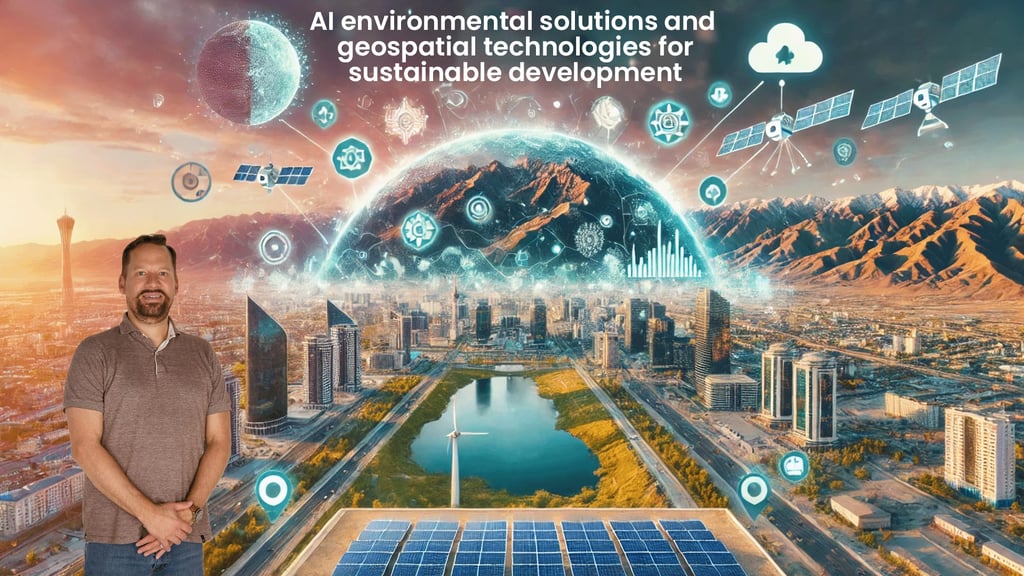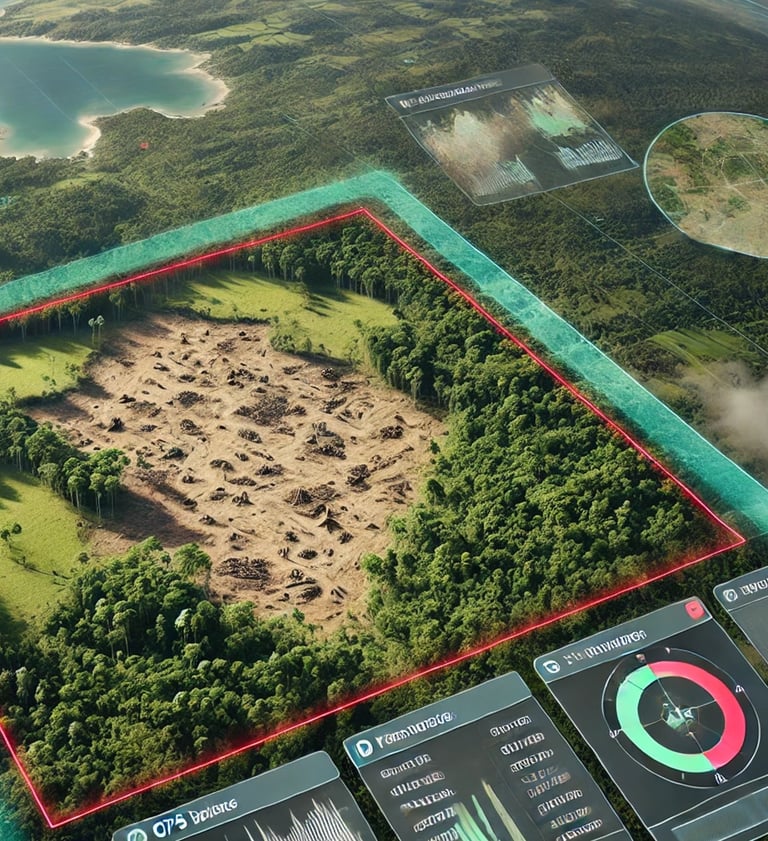Kazakhstan's AI & Geospatial for Innovative Environmental Solutions
How is Kazakhstan turning the tide on environmental challenges with AI and geospatial technologies, and what can other countries learn from their innovative approach? During my recent visit to Almaty, I witnessed firsthand the incredible impact of cutting-edge technology on sustainable development. From tracking deforestation and optimizing water use in agriculture to promoting clean energy with solar panels and electric cars, Kazakhstan is leveraging AI and geospatial solutions to tackle environmental challenges. Dive into the details, learn how these innovations can drive a greener future, and find out how we can help you apply these technologies to your environmental initiatives.
TECH FOR PUBLIC HEALTH
Scott Pezanowski
7/29/20245 min read


Welcome to my latest dive into the transformative world of AI environmental solutions and geospatial technologies in Kazakhstan! During my recent visit to this stunning country, I had the privilege to witness firsthand how cutting-edge technology is making significant strides in environmental sustainability. Join me as we explore the innovative applications of AI and geospatial technologies that drive change and ensure a greener future for Kazakhstan.
Discovering Almaty: A Blend of Tradition and Modernity
Almaty, Kazakhstan's largest metropolis, seamlessly blends the vast Central Asian steppe with a modern, picturesque urban landscape at the foothills of the awe-inspiring Tian Shan mountain range. My recent trip revealed a city rich in culture, architecture, and a solid commitment to sustainability. The tree-lined streets, wide sidewalks, and friendly, diverse community make it a must-visit destination. This unique mix of natural beauty and urban innovation set the stage for my exploration of AI environmental solutions and geospatial technologies.


The Power of AI Environmental Solutions
Artificial Intelligence (AI) is revolutionizing the way we approach environmental challenges. From tracking deforestation to monitoring water quality and optimizing agricultural practices, AI provides powerful tools to analyze and interpret vast amounts of data collected from satellites and ground-based sensors. This real-time information is crucial for making informed decisions that support conservation and sustainable development.
One of the most impressive applications of AI environmental solutions is in natural resource management. In Kazakhstan, AI algorithms process data to monitor deforestation, water quality, and land use changes. This technology helps authorities detect illegal activities, such as logging, by identifying patterns and anomalies in the data. By responding quickly to these insights, they can prevent further environmental damage.


Geospatial Technologies in Kazakhstan
Geospatial technologies play a vital role in visualizing and managing environmental changes. These technologies capture, store, analyze, and present spatial or geographic data, allowing us to see detailed maps and satellite imagery of natural resources. Kazakhstan uses geospatial technologies to track the health of forests, monitor water bodies, and manage agricultural lands.
After my visit, I learned about the collaboration between Planet Labs and Kazakhstan Garysh Sapary (KGS). This partnership leverages high-resolution satellite imagery to monitor various environmental factors across the country. KGS, which operates its own satellites, uses Planet Labs' data to supplement its efforts, ensuring high spatial and temporal resolution. This collaboration highlights the value of geospatial technologies in managing Kazakhstan's extensive natural resources.
Renewable Energy Initiatives
Kazakhstan's commitment to sustainable development is evident in its renewable energy initiatives. Almaty is a shining example of how AI and geospatial technologies optimize renewable energy sources. The solar cells on the Medeu Cable Car and the use of electric cars on Shymbulak Mountain are just a few examples of the city's dedication to clean energy. These initiatives reduce carbon emissions and showcase how technology can enhance the efficiency and output of renewable energy systems.
By integrating AI and geospatial technologies, Kazakhstan addresses its environmental challenges and paves the way for sustainable development. These innovations balance economic growth, public health, and ecological preservation.


The Impact of AI and Geospatial Technologies on Agriculture
Agriculture is a critical sector in Kazakhstan, heavily reliant on irrigation. AI environmental solutions and geospatial technologies significantly improve water use efficiency and crop management. AI-powered models predict water availability and quality, helping farmers optimize irrigation practices. This optimization ensures crops receive the right amount of water, reducing waste and improving yields.
Additionally, drones with sensors and AI analytics monitor crop health, soil conditions, and pest infestations. This data-driven approach allows farmers to make precise interventions, reducing the need for pesticides and fertilizers and helping protect the environment.
Addressing Water Management Challenges
Water management is another critical area where AI and geospatial technologies are making a difference. Kazakhstan's agriculture relies heavily on irrigation, and efficient water management is essential for sustainable farming. AI-powered models can predict water availability and quality, optimizing the use of this precious resource. By ensuring that crops receive just the right amount of water, these technologies help improve water use efficiency and reduce environmental impact.


Visualizing Environmental Changes
One of the most potent aspects of geospatial technologies is their ability to visualize environmental changes. Detailed maps and satellite imagery clearly show how the Kazakhstanis manage natural resources and highlight areas that need attention. For example, in Kazakhstan, these technologies are used to track the health of forests and detect illegal logging activities. By analyzing patterns and anomalies, authorities can respond quickly to prevent further damage.
Collaborating for a Sustainable Future
The collaboration between Planet Labs and Kazakhstan Garysh Sapary (KGS) is a prime example of how partnerships can drive environmental sustainability. By combining high-resolution satellite imagery with AI analysis, they monitor various environmental factors across Kazakhstan. This collaboration enhances the accuracy of environmental monitoring and ensures that conservation efforts are effective and timely.
Promoting Clean Energy
Kazakhstan's commitment to clean energy is evident in its renewable energy initiatives. In Almaty, solar cells on the Medeu Cable Car and electric cars on Shymbulak Mountain demonstrate the city's dedication to reducing carbon emissions and promoting sustainable energy solutions. AI and geospatial technologies ensure maximum efficiency and output by optimizing the placement and operation of renewable energy sources.


Conclusion
My recent visit to Kazakhstan opened my eyes to the incredible potential of AI environmental solutions and geospatial technologies in addressing environmental challenges. From monitoring natural resources to optimizing renewable energy systems, these technologies pave the way for a sustainable future.

Check out the full video to learn more about Almaty, Kazazkstan.
”[Scott] is now providing invaluable resources about GeoAI, especially in the public health context, to help people in different fields build a better Earth village that we all live in.”
- Dr. Liping Yang | Geography and Environmental Studies and Computer Science, University of New Mexico


Call to Action
Are you facing similar environmental challenges in your region? Are you looking to leverage AI environmental solutions and geospatial technologies for sustainable development? I can help! With over 20 years of experience in AI, machine learning, geospatial technologies, and data analytics, I provide consulting and development services to address real-world challenges in public health, environmental factors, and beyond.


